I have always loved writing. I know that isn’t the case for a lot of the kids in our classrooms so each year I make it a goal to help kids feel confident in writing so that someday they might find that love for it…or at least confidence.
There are a lot of things that go into a supportive learning environment and effective writing workshop. Before I can effectively teach writing, I need to make sure I have all the right tools and supports in place for ALL my young authors! I will tell you 5 Essential Elements of a Successful Writing Workshop.
1. Writing Utensils that Accommodate all Learners
First, a variety of writing utensils. I always make sure I have a large array of writing tools for my students to choose from. I know how picky I am with what I write with, so I’m sure my students have preferences too.
My goal in using the variety of writing tools in the classroom is to inspire kids to write and to assure that their little hands are comfortable while building that writing endurance. Now, before you hesitate and think of the arguing over materials, just establish expectations and a simple sharing plan. If you have fancy pens, they will be popular at first, but that novelty will wear off and kids will use what they need in the end.
What does this look like in the classroom?
- Flare pens
- Short and tall pencils
- Gel pens
- Other fun pens (in colors I can read ha!)
- Highlighters
- Technology (keyboarding)
- Fine motor support tools (grips, etc.)

I use gel pens to inspire those reluctant writers. They love using your special materials. If it works, goal met, they are writing. Highlighters are a great tool to help your low buddies who need a lot of help forming letters and or sentences. I will often write out a student created sentence in highlighter for them to trace over. It’s good practice for letter formation and they have something on the paper. Win Win. Technology if you have it, gives confidence to that kiddo that looks at the paper and automatically gets anxiety. We were fortunate enough to have talk to text and predictive text programs, but sometimes just typing can get those students creating.
How do I incorporate this?
It took me a while to build up a supply of materials. I have asked parents for donations, put them on the supply list, Donor’s Choose, Dollar Tree scores and you guessed it out of pocket purchasing. Also, Amazon and Target have everything you could dream of when creating a writing tool selection for your classroom.
2. Graphic Organizers that Accommodate all Learners
 One size does not fit all. I always have a handful of graphic organizers in use in my classroom. There is such a wide range in writing ability within our classrooms, so kids will need different supports. My goal is that they create a writing piece that they feel confident in and it hits the targets specific to the genre. If I focus on that as my goal, what the process looks like to get there doesn’t matter. Don’t get stuck on what kids SHOULD be able to do, if they can’t yet, how will you get them there? Let’s hope they won’t need the additional supports for long, but we have to build that confidence. These materials are always on hand and organized in my classroom writing workshop area. I also send a copy of all of these materials to parents so they can support their kids at home.
One size does not fit all. I always have a handful of graphic organizers in use in my classroom. There is such a wide range in writing ability within our classrooms, so kids will need different supports. My goal is that they create a writing piece that they feel confident in and it hits the targets specific to the genre. If I focus on that as my goal, what the process looks like to get there doesn’t matter. Don’t get stuck on what kids SHOULD be able to do, if they can’t yet, how will you get them there? Let’s hope they won’t need the additional supports for long, but we have to build that confidence. These materials are always on hand and organized in my classroom writing workshop area. I also send a copy of all of these materials to parents so they can support their kids at home.
What does this look like in the classroom?
- Multiple line styles including colored for my fine motor kids
- Graphic organizers with sentence starters or transitions included
- Picture options to help kids generate those ideas
- Graphic organizers with question prompts
- Digital graphic organizers
How do I incorporate this?
Over the years I have fine-tuned many different templates through trial and error, research and collaboration with fellow educators. I am always updating my materials to meet the needs of students. You can get my ready to go graphic organizers in my store. I have genre specific and generic templates that support all leveled learners that you can print and use same day in your classroom writing workshop.
3. Mentor Posters, Anchor Papers, Checklists… Oh My!
Checklists I don’t know about you, but I am a list girl. I cannot function without a checklist of what I need to accomplish for the day, event, whatever. Again, we should assume that some kids also have these same needs. It can be overwhelming to look at a large task and not know where to start. Also, kids can lose momentum looking and what’s left, but with a checklist they can lessen anxiety or worry seeing what they have already accomplished.
Anchor Papers & Materials I love providing kids with samples of what they should be shooting for. Having an anchor paper of what I am expecting from them in a final piece is so important. I used to worry that kids would copy my anchor paper but then I reflected that they must need that support and I can then meet with that kiddo and have a quick mini lesson on putting thing things in their own words or I proved them with a different graphic organizer that provides some of the steps so they can focus on generating their own ideas. Another strategy is having your anchor paper on a different topic but genre specific or generate ideas that you keep on a chart up front for kids to borrow or modify.
Another great resource is a student dictionary. My kids always have theirs out on their desk during writing workshop. It has grade level words, “juicy” adjectives, common vocabulary, word banks, sentence starters, space to write their own words they want to remember and more.
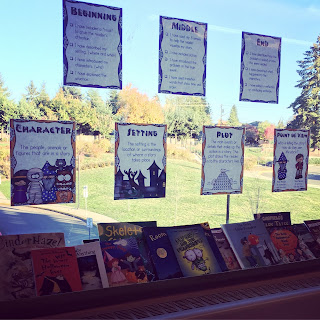 Mentor Posters This is a lot like having anchor papers showing our students what our goals are. Mentor posters with genre specific rules, components and suggestions are great for kids to access. I have these up on my writing workshop wall all year long. I rotate out during genres and also for fun themed writing topics. I also have mentor lists I keep in my students writing workshop journals that are specific to the genre, such as genre specific transition lists. Another great resource for your writing workshop is themed adjective lists that kids might like to use in their writing.
Mentor Posters This is a lot like having anchor papers showing our students what our goals are. Mentor posters with genre specific rules, components and suggestions are great for kids to access. I have these up on my writing workshop wall all year long. I rotate out during genres and also for fun themed writing topics. I also have mentor lists I keep in my students writing workshop journals that are specific to the genre, such as genre specific transition lists. Another great resource for your writing workshop is themed adjective lists that kids might like to use in their writing.
What does this look like in the classroom?
- Mentor posters & anchor papers up on the walls or document camera
- Dictionaries out on desks
- Checklists on desk or attached to privacy screens
- Brainstorm lists up where kids can access them or easily see
How do I incorporate this?
There are so many great resources out there to help support your students with writing workshop expectations and goals. Hop on Pinterest and instantly inspire that creativity or brainstorm with students to create collaborative and personal anchor charts. I have also created a plethora of resources that my students use on a daily basis during writing time. I have linked a few below.
4. Flexible Space that Accommodates all Learners
We all have heard of flexible seating. Writing workshop is the perfect time to allow for student choice of seating. As I said earlier, I love to write, but I can only write well in certain environments. I need small distractions; white noise is ok, and I have to write at a desk our countertop. No on the lap writing for this girl, but I am fully aware that is not true for all people. You don’t need to have fancy flexible seating furniture for this. Something you MUST have is flexible expectations of what writing workshop looks like.
What does this look like in the classroom?
- Kids writing on clipboards spread around the room
- Kids laying on the floor writing
- Kids standing at desks writing
- Kids wiggling or rocking as they write
- Kids sitting at desks or tables writing
- Kids maybe outside the classroom in a quiet space
- A kiddo or two at my horseshoe table or desk that need a little more support
How do I incorporate this?
You simply have to be open to a flexible space. You have to think outside of the environment you personally need to be a productive writer. Keep expectations clear. “If you are on task writing, you can choose your writing space. If you aren’t, I will support you in choosing a just right space to be productive.”
5. Support Tools
First of all, I want you to know I have most of these materials out throughout the entire school day. I want kids to be able to access what they need to be in the write zone for learning. Establishing clear expectations on use of materials is a must. What I love about having support tools out for all students all day is that they become used to seeing them, anyone can use them, no one feels different and best of all it helps kids access the academics.
Now, I have a lot of tools I use in my classroom that I have built up over the years, but the ones I couldn’t live without are headphones, privacy screens, and timers.
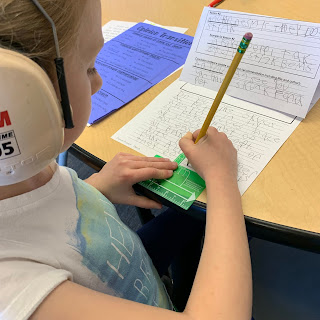 Headphones My all-time favorite tool is headphones. At first kids feel funny grabbing them, but by a few weeks into school all my headphones are in use. They can still hear me when I need them to, and we have a symbol for removing them. It drowns out the loud noises and also alerts neighbors that they are trying to concentrate so don’t chat with me.
Headphones My all-time favorite tool is headphones. At first kids feel funny grabbing them, but by a few weeks into school all my headphones are in use. They can still hear me when I need them to, and we have a symbol for removing them. It drowns out the loud noises and also alerts neighbors that they are trying to concentrate so don’t chat with me. 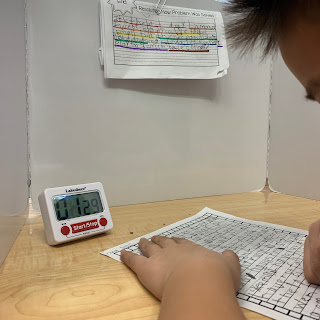 Privacy Screens I used to have home-made privacy screens and those work great, I recently upgraded to Lakeshores, and man they are durable. I have kids put these up every time during writing. It blocks off distractions and lends as a space to post support materials. Some simple paper clips can help to move important support materials out of their physical writing space and place them at eye level for continual check in.
Privacy Screens I used to have home-made privacy screens and those work great, I recently upgraded to Lakeshores, and man they are durable. I have kids put these up every time during writing. It blocks off distractions and lends as a space to post support materials. Some simple paper clips can help to move important support materials out of their physical writing space and place them at eye level for continual check in.
Timers I have always had a couple kids that love competition or have no idea how long things take them and a visual timer is so helpful. PLEASE note that I do not decide on how much time the kids get by myself. I talk with the student and we come up with a set time on how long we think they should need for a set task. If they beat it hooray! If not, we reflect and give more time. This is not for everyone. It does help a good handful of kids in my classroom. I have used sand timers, kitchen timers and visual timers where the red disappears as time goes on.
What does this look like in the classroom?
- A cubby full of privacy screens that kids can access at any time
- I have a bin of noise cancelling headphones that kids can access at any time
- I have a tub of timers at my teaching station. Kids come and check them out from me, this helps me to have a quick conversation about the goal and timer expectations
** Kids you know could benefit aren’t utilizing the materials. I walk around with them and hand them out. I ask kids to give them a try. Most end up loving them. Some kids simply forget to grab them.
How do I incorporate this?
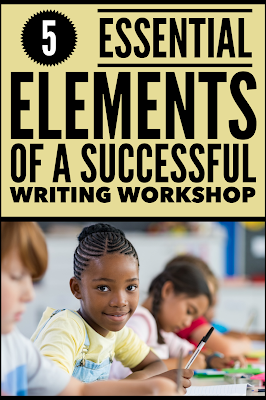 Asking for donations is the biggest support of these materials. I sent out a list of some things I would love to have in our classroom to support kids. What’s the worst that could happen? They don’t send them in. I found many parents would like to help out in a room, but maybe can’t volunteer time, but maybe they can donate a material or two. I also have written many Donor’s Choose grants. Once you build up a support tool library make sure that you go over expectations to keep those materials in tip top shape and lasting you for years to come.
Asking for donations is the biggest support of these materials. I sent out a list of some things I would love to have in our classroom to support kids. What’s the worst that could happen? They don’t send them in. I found many parents would like to help out in a room, but maybe can’t volunteer time, but maybe they can donate a material or two. I also have written many Donor’s Choose grants. Once you build up a support tool library make sure that you go over expectations to keep those materials in tip top shape and lasting you for years to come.
Overall, the most import things you can do to ensure you will have a successful writing workshop are to be flexible, reflective and encouraging. Supporting and inspiring young writers is a lot of work and I know you can do it!

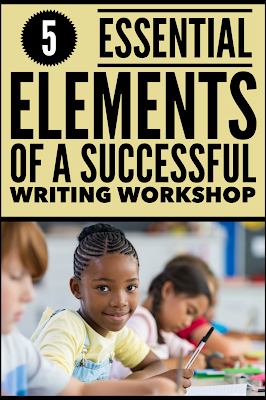






Leave a Reply